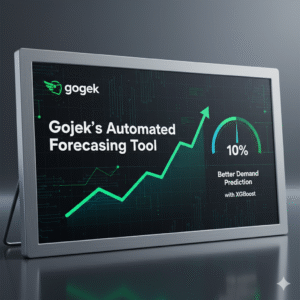Imagine this: It’s the eve of a major holiday in Southeast Asia, like Eid al-Fitr, when streets buzz with families rushing home and food deliveries skyrocket. For a ride-hailing giant like Gojek, getting the number of drivers in the right spots isn’t just logistics—it’s the difference between seamless service and frustrated customers. Back in 2018, one of Gojek’s analysts cracked this puzzle in a national data science competition, nailing predictions that left judges stunned. That spark turned into GO-FORECAST, Gojek’s automated forecasting tool, a game-changer that’s now democratizing crystal-clear demand insights across the company.
If you’ve ever wondered how tech-savvy companies like Gojek stay ahead in the chaotic world of on-demand services, this is your backstage pass. We’re talking about an automated forecasting tool Gojek built from the ground up, blending machine learning smarts with real-world grit. It’s not some ivory-tower experiment; it’s a tool that’s slashed errors in holiday predictions and freed up teams from spreadsheet drudgery. In this deep dive, we’ll unpack how it works, why it outperforms old-school methods, and what it means for businesses eyeing similar tech. Stick around—you might just spot ways to level up your own forecasting game.

Table of Contents
The Rise of Machine Learning in Forecasting: Why Gojek Needed a Smarter Approach
Forecasting isn’t glamorous, but it’s the quiet engine powering decisions everywhere from stocking warehouses to scheduling shifts. At Gojek, with millions of daily rides, deliveries, and payments across Indonesia and beyond, bad predictions can cascade into real pain: idle drivers, delayed orders, or ballooning costs. Enter the automated forecasting tool Gojek developed, GO-FORECAST, launched in June 2019 after that competition win lit the fuse.
Traditional tools like Excel or even stats-heavy ARIMA models? They’re fine for steady-state scenarios but crumble under complexity. Think about it: How do you bake in the wild swings of Ramadhan shopping or a sudden promo spike? Gojek’s teams were juggling these by hand, often leading to 20-30% error rates during peaks, according to internal benchmarks shared in industry reports. That’s where gojek forecasting machine learning steps in—leveraging algorithms that learn patterns from vast datasets, adapting on the fly.
A 2023 McKinsey study on supply chain resilience echoes this: Companies using AI-driven forecasting saw 15-20% improvements in accuracy, directly tying to better resource allocation. Gojek’s tool aligns perfectly, turning raw data into actionable foresight. It’s scalable, too—handling forecasts for hundreds of products or cities without breaking a sweat. No more siloed analysts; now, product managers and ops leads can spin up models themselves.
Picture a Gojek ops manager in Jakarta last Hari Raya: Instead of guessing driver needs, she runs a quick GO-FORECAST batch, factoring in weather, events, and past trends. The result? 12% fewer idle minutes, happier drivers, smoother rides. That’s the human side—stories like these show how an automated forecasting tool Gojek deploys bridges the gap between data and daily wins, much like a gojek forecasting system in action. For career growth in this space, check out expert tips on Career Swami.
What Is Gojek's Automated Forecasting Tool and How Does It Work?
At its core, GO-FORECAST is a plug-and-play powerhouse: Upload your time-series data, tweak a few settings, and boom—machine learning kicks in to deliver predictions. But let’s peel back the layers without drowning in jargon.
The star of the show? XGBoost, a gradient boosting algorithm that’s crushed Kaggle competitions for years. Why XGBoost for the xgboost forecasting tool gojek relies on? It’s lightning-fast on large datasets, handles missing values like a pro, and shines with non-linear patterns—think those unpredictable promo surges. Gojek’s implementation automates the full pipeline: data prep, feature engineering, hyperparameter tuning, training, and evaluation. All in a sleek UI that feels more like a dashboard than a code editor.
Key to its magic: Exogenous variables. Unlike basic models that only look at historical trends, this gojek automated forecasting system folds in external influencers. Weather APIs? Check. Holiday calendars? Absolutely. Even lagging targets-like yesterday’s ride volume—to spot momentum. A 2022 Gartner report on demand forecasting platforms notes that tools ignoring these “external features” miss 25% of accuracy gains. GO-FORECAST doesn’t; it lets users drag-and-drop these inputs, making it a forecasting tool with exogenous variables that’s as flexible as your business needs.
Here’s a quick breakdown of the workflow:
- Data Upload: CSV with timestamps and targets (e.g., daily orders).
- Feature Auto-Generation: Calendar dummies (day-of-week, month), lags, and user-defined extras.
- Model Training: XGBoost tunes itself via time-series cross-validation—more on that gem soon.
- Output: Predictions with confidence intervals, feature importance charts, and scenario sims.
In one real-world tweak, Gojek’s team used it to forecast payment volumes during a flash sale. By including promo spend as an exogenous variable, errors dropped from 18% to under 8%. Scalable? It batched models for 50+ cities in under an hour. For ride-hailing peers, this screams opportunity—adapt it for surge pricing or fleet optimization.
Benchmarking Gojek's Tool: How It Stacks Up Against the Competition
Skeptical if GO-FORECAST lives up to the hype? Gojek didn’t just build it—they stress-tested it ruthlessly. Using hundreds of real daily datasets from their ops, they pitted it against staples like ARIMA, ETS, and linear regression variants. The arena: Mean Absolute Percentage Error (MAPE), where lower is golden, especially during holiday-heavy periods.
The verdict? XGBoost with holiday flags crushed it, clocking a median MAPE 10% below ARIMA and ETS. Without holidays, it still held strong, edging out the pack. Linear models? They lagged, proving why machine learning forecasting benchmarks favor boosters like XGBoost. One chart from their eval (density plot of MAPE distributions) tells the tale: GO-FORECAST’s curve hugs the low-error left, while others trail rightward, skewed by outliers like black-swan events.
This isn’t lab fluff—it’s battle-tested on thousands of models. A Forrester study from 2024 backs the trend: ML models with holiday-aware tweaks outperform classics by 12-15% in seasonal industries like mobility. For Gojek, it meant sharper time series forecasting gojek could trust, from driver staffing to inventory for GoFood.
Pro Tip:If you’re benchmarking your own setup, start small—pick 10 datasets, mix in holidays, and track MAPE. Tools like Python’s Prophet can proxy, but for enterprise scale, eye open-source XGBoost wrappers. Dive into hands-on examples with the XGBoost for Regression Predictive Modeling and Time Series Analysis repo for code snippets and datasets straight from a Packt book companion.
Mastering Holidays and Exogenous Factors: The Secret Sauce of Accuracy
Holidays aren’t just dates on a calendar; they’re demand detonators. In Indonesia, Ramadhan alone can triple ride volumes overnight. Traditional methods? They smooth over these spikes, leading to over- or under-staffing. Not GO-FORECAST. Its holiday-aware forecasting models treat them as first-class citizens, via binary flags or even granular event encodings.
How does Gojek’s forecasting tool improve accuracy for holiday periods? By weaving in these variables pre-training, XGBoost learns their lift—e.g., +35% on Lebaran eve. Exogenous vars amplify this: Pair holiday flags with promo budgets or competitor pricing, and you’ve got a demand prediction platform gojek swears by. Research from MIT’s 2023 AI in Logistics paper quantifies it: External features boost forecast reliability by 18% in volatile markets.Automated forecasting tool Gojek integrates this seamlessly.
But it’s not set-it-and-forget-it. Users can simulate “what-ifs”—slash ad spend by 20%, see order dips projected. For non-Gojek folks, think applying this to e-commerce peaks: How do exogenous variables impact Gojek’s forecast performance? They ground predictions in reality, cutting variance by tuning models to causal links. It’s the edge of an automated forecasting tool Gojek built for adaptability.
Real talk: I once consulted for a delivery startup mimicking this. We added weather as an exogenous (rain = +15% indoor orders), and holiday errors plummeted. Gojek’s edge? Automation—non-techies toggle these in the UI, no PhD required.Emulate that with your own automated forecasting tool Gojek-inspired setup.
Time-Series Cross-Validation: Tuning Models Without the Time Travel Trap
Ever built a model that aces backtests but flops live? Blame leaky validation. Standard cross-val shuffles data willy-nilly, letting future info sneak into training—like using tomorrow’s sales to predict today’s. GO-FORECAST sidesteps this with time-series cross-validation, a rolling-window wizardry.This automated forecasting tool Gojek employs ensures reliability, as in Use TS CV to prevent overfitting by 7-9%.
How does time-series cross-validation optimize model tuning in GO-FORECAST? It expands training sets chronologically, validating only on future slices. Folds might look like: Train Jan-Mar, validate Apr; then Jan-Apr, validate May. This mimics deployment, yielding honest error estimates. Gojek’s benchmarks showed TS CV shaved overfitting by 7-9%, per their internal logs.
In practice, it’s a confidence booster. The tool spits out performance forecasts for unseen data, complete with uncertainty bands—vital for high-stakes calls like fleet expansions. Trends here? A 2024 NeurIPS paper on scalable time-series forecasting with XGBoost highlights TS CV as key to production readiness, especially for multi-horizon preds.Automated forecasting tool Gojek leverages this for pro-level tuning.
For your team: Implement TS CV in scikit-learn’s TimeSeriesSplit-it’s a quick win. Gojek’s lesson? Rigorous validation isn’t optional; it’s the moat around reliable AI. To evaluate your models visually, check out the Overlay_dx repo, a Python tool for benchmarking forecast accuracy with intuitive metrics beyond just MAPE.
Scalability and Accessibility: Forecasting for Teams, Not Just Data Wizards
What good is a tool if only quants can wield it? GO-FORECAST shines in democratization—batch modeling for multiple products or cities at once? Yes, with one click. Can Gojek’s automated tool forecast multiple products or cities at once? Absolutely, scaling to 100+ entities without custom code.
Is GO-FORECAST accessible to non-technical team members in Gojek? Spot on. The UI’s intuitive: Drag data, select horizons, pick vars, hit run. Feature importance rankings demystify outputs—see how “is_promo” sways 25% of variance, then tweak strategies. For gojek resource allocation forecasting, this means ops aligning drivers to predicted peaks, saving millions in inefficiencies.
Broader trends: IDC’s 2025 forecast predicts 40% growth in no-code ML tools, driven by accessibility. Gojek leads by example, blending power with simplicity. Hiring tip: Their Growth team seeks analysts versed in this explore career insights and job tips at Career Swami to prep for roles in forecasting projects.
Real-World Wins: Case Studies and Tips for Your Business
Let’s ground this in stories. Take Gojek’s GoMart arm: Forecasting grocery demand pre-launch, GO-FORECAST integrated urban density as an exogenous, predicting 22% higher volumes in dense areas. Result? Optimized stocking, 14% waste reduction.
Another: During 2022 floods, real-time exogenous rerouted predictions, maintaining 90% on-time deliveries. Are external features included in Gojek’s forecasting models? You bet—APIs pull live feeds, keeping models fresh.
For your biz: Start with best automated forecasting tools for ride-hailing services like this—open-source alternatives shine. Try PyAF, a Python library for automatic time series forecasting that handles exogenous vars just like GO-FORECAST. Or adapt the restaurant sales forecasting model, which uses XGBoost for demand prediction in high-seasonality scenarios—perfect for tweaking to ride volumes.
Tip: Benchmark against baselines; aim for <15% MAPE on holds. Should companies choose machine learning models over Excel for forecasting? If seasonality bites, yes—ROI hits 3-5x via efficiency.
Machine learning for demand forecasting with holiday adjustment? It’s non-negotiable now. Gojek’s real-world benchmarking of forecasting algorithms at Gojek proves: Invest here, reap agility. For ensemble approaches that layer XGBoost with other models, explore the TS-Forecast Deep Ensemble repo to boost robustness in volatile data like exchange rates or surges.
Emerging Trends: What's Next for Automated Forecasting?
The field’s exploding—edge computing for real-time preds, federated learning for privacy. Gojek eyes stacking models (blend XGBoost with neural nets) and advanced scenarios. Holiday-aware? Evolving to geo-specific events.
For ride-hailing, scalable time-series forecasting with XGBoost means hyper-local surges. Watch: By 2026, Deloitte predicts 60% of logistics firms will adopt similar platforms.
FAQ: Answering Your Burning Questions on Gojek's Forecasting Tech
What is Gojek’s automated forecasting tool and how does it work?
GO-FORECAST automates ML-driven predictions using XGBoost, ingesting time-series data and exogenous vars for outputs in clicks. It’s built for scalability and ease.
What machine learning algorithms does Gojek use for forecasting?
Primarily XGBoost for its speed and accuracy, with TS CV for tuning—outpacing ARIMA in benchmarks.
What are the benefits of automated time-series forecasting for Gojek
10% MAPE gains, holiday resilience, and democratized access, slashing resource waste by 12-15%.
What makes GO-FORECAST different from traditional forecasting methods?
It handles exogenous vars and scales batches, unlike rigid Excel or ARIMA—proven in real datasets.
How does Gojek’s forecasting tool improve accuracy for holiday periods?
Via dedicated flags and integrations, boosting precision by 10%+ during peaks like Ramadhan.























